And so, we come to the end of the world where the Patron Saint of Wales sleeps by the Western Sea.1
Recently, to parallel my own holiday to St David’s Head in West Wales, I blithely told my friends that Abbess Cyneswithe was on pilgrimage to St Patrick’s Chapel at Whitesands Bay, near to St Davids city and cathedral in Pembrokeshire, and that two pilgrimages to St Davids was equivalent to a pilgrimage to Jerusalem. But is this historically correct? One rainy afternoon in the historic cottage of Ty Gwyn, which is now helpfully supplied with wifi via satellite, I settled down to consider the question.
Saints Patrick and David
Let us begin with Saints Patrick and David, who are both intimately associated with St David’s Head. The Romano-British Patrick (385 – 461 CE) departed from Whitesands Bay on his way to Ireland where he became a Christian missionary and bishop.2 David (500 – 589 CE) was a Welsh bishop of Mynyw (now St David’s) during the 6th century and is the patron saint of Wales.3 He founded his monastery as close to Ireland as possible, on St David’s Head – only forty miles by sea, far more accessible than London or Winchester. What was the status of St David’s monastery in 922?
Saint David’s monastery and pilgrimage
The monastic community was founded by Saint David, Abbot of Menevia, who died in 589. Between 645 and 1097, the community was attacked many times by raiders, including the Vikings; however it was of such note as both a religious and an intellectual centre that King Alfred summoned help from the monastic community at St Davids in rebuilding the intellectual life of the Kingdom of Wessex.
… In 1090, the Welsh scholar Rhigyfarch wrote his Latin Life of David, highlighting David’s sanctity, thus beginning the almost cult-like status he achieved.
…In 1123, Pope Calixtus II granted Bishop Bernard’s request to bestow a papal privilege upon St Davids, making it a centre of pilgrimage for the Western world; the Pope decreed that “Two pilgrimages to St Davids is equal to one to Rome, and three pilgrimages to one to Jerusalem”.4
It appears I was mistaken; St David’s official status as a site of pilgrimage was not established until Norman times, and two visits would have equated to Rome only, not Jerusalem. However the monastic community was active and respected, and St Patrick’s shrine was significant. Can we posit a journey by our early tenth century abbess as a personal devotion, or on some church business?
Saint Patrick’s shrine at Whitesands Bay
There is a tradition that St. Patrick set sail from this beach in 432 AD to convert Ireland to Christianity. The site of a Celtic chapel, dedicated to St Patrick, is located under a mound by the car park just to the east of the bay, at what is thought to have been the disembarkation point for pilgrims to St Davids Cathedral. St David may have been educated at Ty Gwyn, the white farmhouse that overlooks the beach, by St Paulinus, and St Non, David’s mother, may have lived here when it was a monastery. The burial ground was in use from the 8th to 11th centuries, and remains have been removed by Dyfed Archaeological Trust to the National Museum of Wales to preserve them from coastal erosion.5
Whitesands Bay has a long, if debated, history as a major port. It was once accepted to be overlooked by a Roman station named Menevia, but this idea appears to be based on the forgery “The Description of Britain”.6 7
However the Roman road Ffordd Fleming ran to St Davids8 and it seems likely that Porth Mawr, “Great Port” or Whitesands Bay was a major shipping destination, being easily reached by walking down a shallow valley and an excellent place from which to travel to Ireland.
A more recent Roman connection has been hypothesised by Dr Mark Merrony based on the observation of a Roman route across the Preseli Hills which appears to lead to St Davids. Possibly the Romans used this route to trade with Ireland; perhaps this was even the route by which the Stonehence bluestones were transported from the Preseli Hills to Wiltshire?9
Ty Gwyn
My final source of written information is the “Historical and other local information” folder kept in the cottage of Ty Gwyn, overlooking Whitesands Bay and the site of St Patrick’s Chapel. This was compiled by John Beer, the previous owner of the cottage, who inherited Ty Gwyn from his ancestors of the Evans family. This writing is perhaps a little on the optimistic side, as it appears to accept the “the Description of Britain”. However, I reproduce several entries.
Rhygyfarch (Bishop of Menevia from 1088-1096) wrote the most significant account of St David some 500 years after his death. In his writing Rhygyfarch would have relied on oral tradition due to the repeated sackings of St David’s cathedral between 795 and 1088 and the destruction of written records.
According to Rhygyfarch the Welsh name of David’s father was Sant or Sandde (which translates into Saint), son of Ceredig, founder of the kingdom of Ceredigion (Cardigan). His mother’s name of Non implies ‘a nun’. Sant was probably a monk in the monastery of Maucen or mancen at Ty Gwyn, Whitesands. According to historians Baring-Gould and Fisher (Lives of the British Saints 190):
This establishment was probably a double monastery, or rather a school to which were admitted pupils of both sexes. Non may therefore have been a pupil when she conceived, and not a nun who had taken vows.
She left the monastery of Maucan and went to a cottage on the cliffs beyond Bryn-y-Garn (next to Warpool Court Hotel, St David’s), above a little bay that now bears her name. Here she remained until she brought forth her child.
When Non had given birth, Bishop Ailbe, who had refused to say mass with her in the church, came over and baptised the child in a spring at Porthclais.
David was sent at a suitable age to be instructed at Yr Henllwyn or Vetus Rubus, ‘the Old Bush’, the same place as Ty Gwyn over which Paulinus was now abbot. It probably got the name of Alba, or rather Alba Domus or Ty Gwyn when it was whitewashed. It is said to have been founded by St Patrick.
David grew up full of grace and lovely to be looked at. And he learned there the rudiments – the psalms, the lessons of the whole year, and the Mass; and there his fellow disciples saw a dove with a golden beak teaching him and singing the hymns of God.
David remained under Paulinus for ten years. Then after Paulinus retired, he was replaced by David whose inheritance gave him a right to the post. From Ty Gwyn St David travelled to establish some of his many churches in South Wales, leaving his uncle Guistlianus in charge.
Following his travels, David returned to Ty Gwyn and decided that the site was undesirable. Rhygyfarch claims that David told his uncle:
From this spot scarce one in a hundred will go to the Kingdom of God. I know another spot whence few will go to hell; for everyone who shall be buried in that cemetery in sound faith will obtain mercy.
And so David moved his religious community into the Valley of Roses in St David’s, where the cathedral stands today. The main reason for this decision no doubt lies in the exposed nature of Ty Gwyn, which could be seen by pirates on the sea. It was therefore expedient for them to go further inland, and to settle on a spot concealed from the sea, and less exposed.
Local legend has it that when St David started to build his first church at Whitesands, the walls and foundation were mysteriously destroyed one night. Following the guidance of an angel, he then decided to build in the valley where the cathedral now stands.
The Penarthur inscribed crosses, now in the west end of St David’s Cathedral, including the Gumarc stone, are said to have originated at the monastery of Ty Gwyn.10
Ty Gwyn remained as a tiny hamlet owned by small-scale farmers with close connections to the sea.
Extract from: S Baring-Gould’s book “in Dewisland”, Methuen 1904
A fictional account of life in West Wales, set during the Rebecca Riots (1839-1843) 11“Ty Gwyn was an old and rudely constructed farmhouse, with a yard before it enclosed within a stone wall, and in this yard stood the shed in question. It pointed east and west, was built of great blocks of red sandstone, unset in mortar. This had been an ancient chapel, and about it, in the yard and in the garden, were numerous graves, tombs rudely constructed of slabs set on end, and with slate-covering stones. One of these graves was utilised as a pig trough. Another received the drainage of the cowhouse. Many of these early Christian graves had been destroyed, and the slabs employed in the walls; but more remained, and were struck by pick and spade when the garden was cultivated. The chapel has disappeared since the time when the events recorded in this tale occurred, and the old farmhouse was pulled down to make way for the present dwelling-house, that was erected forty years ago.”
“Historical and other local information” folder, kept at Ty Gwyn farmhouse
Sabine Baring-Gould, an English Victorian, was an Anglican priest, hagiographer, antiquarian, novelist, folk song collector and eclectic scholar. His account suggests that the early medieval chapel associated with St David’s education may have been finally demolished around 1800.
John Beer writes that he remembered slate slabs resting against the walls of the old garden in front of the building next to Ty Gwyn, but when the garden walls were levelled, the slates were buried under the car park chippings.
Rhygyfarch names David’s place of education as vetus rubus. 12 Christian inscribed stone and cist burials have been found at Ty Gwyn13, and the location overlooking Porth Mawr is significant. The identification of Ty Gwyn as vetus rubus was proposed by Baring-Gould and Fisher, and I think it is a very plausible idea. 14
There seem to be competing traditions for David’s birthplace; local tradition puts it in Caerfai Bay, now marked by St Non’s chapel, less than an hour’s walk from St David’s15 while by other accounts he was born at Henfynyw (Vetus-Menevia) in Ceredigion, though it may be simply that he spent time there as a youth.16
Recent excavations at St Patrick’s chapel
Because of the rising sand levels, the site of St Patrick’s chapel at Whitesands Bay contained nearly a thousand years of sequential use, each new layer doing little to disturb those below. Sadly, because of coastal erosion starting with severe storms in 2014, the archaeology has been entirely removed by rescue operations and is now in storage somewhere. The excavations have revealed the changing nature and use of this deeply sacred site. 17 18 2021’s dig is as yet unpublished but Luke Jenkins of Dyfed Archaeological Trust summed up the latest findings in a very excellent lecture in December 2021.19
Three main phases of occupation have been revealed. The first is an early Celtic Christian structure which resembled Irish Leacht shrines – small square or rectangular drystone platforms thought to function as a burial place, a shrine or an altar, and found in association with early monastic sites. These are unknown in England but well known in Ireland, only 40 miles away.20 21 22
The structure at Whitesands Bay was a “lemon shaped” enclosure built of water-worn beach boulders, around 4m east-west by 9m north-south, accessed by a stone stile on the western side facing the sea. At the centre of this enclosure stood a stone box-shaped structure, filled with fine sand and topped with more flat stones. This box contained no bones, but was surrounded by the graves of infants, cut as close to the box as possible. One of the side stones has a carved cross on it, the cross having been set on the inside of the box so that it would not have been visible – and the stone itself is currently on display at the Oriel y Parc visitor centre in St David’s. This proves the structure to be Christian, and not neolithic, and I will refer to it as a shrine.
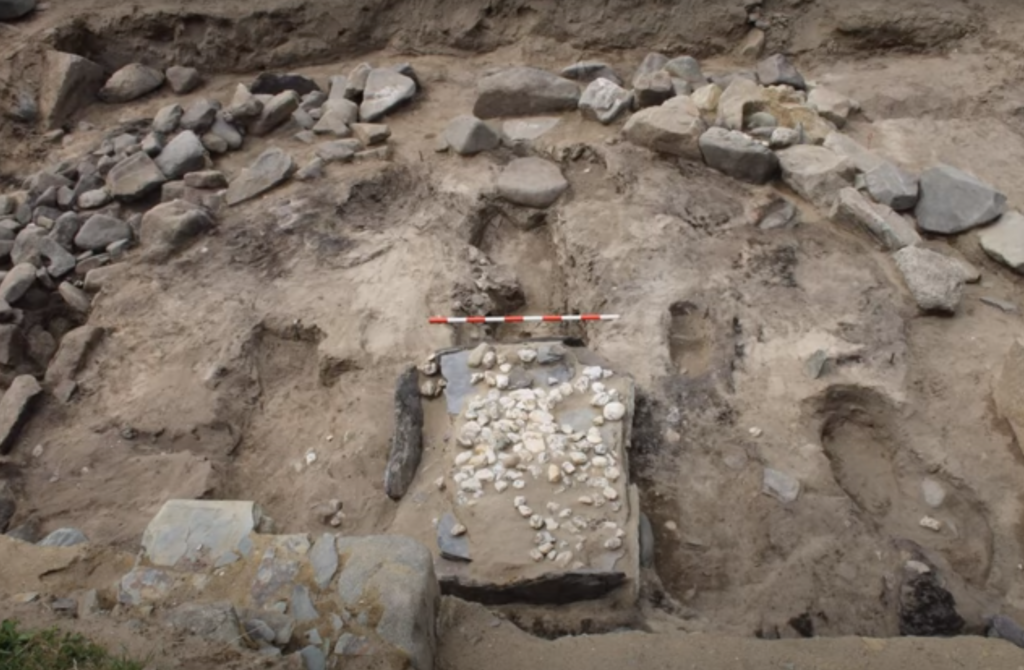
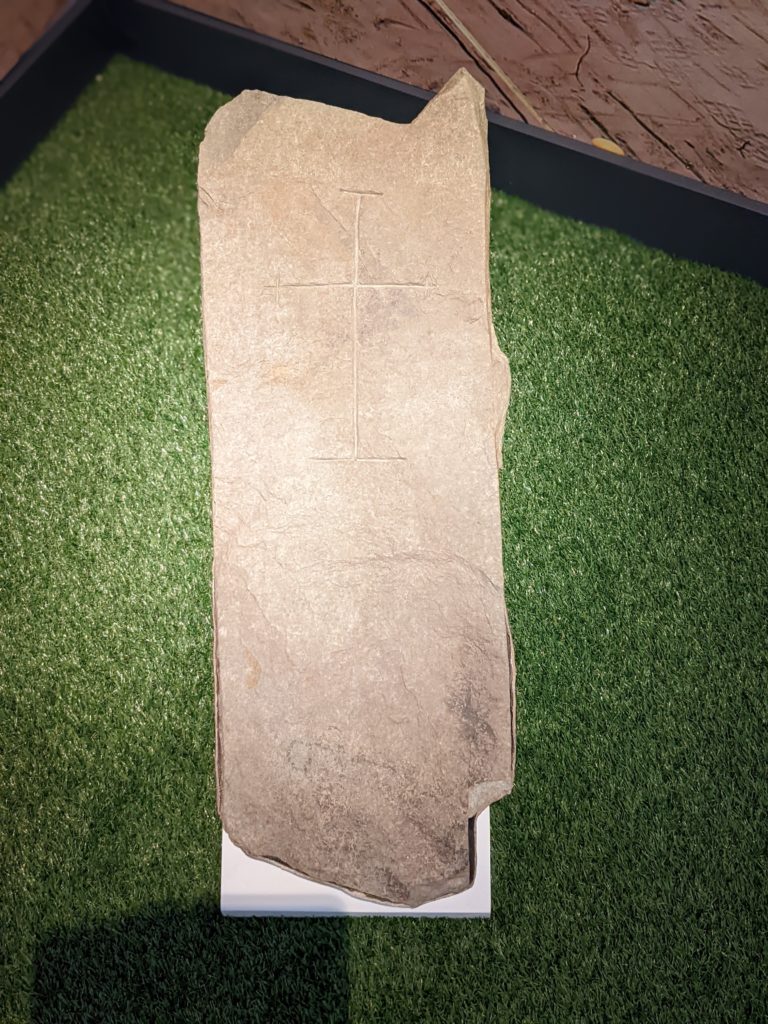
The interior of the enclosure was roughly paved with quartz pebbles, and more quartz stones were placed on the flat stones forming the top of the shrine. These flat stones were inscribed with a Celtic knotwork cross, a human figure standing next to some structure, and part of a square grid which look very like a gaming board. Another stone was laid on the shrine with a similar grid again suggesting a hnefetafl or similar gaming board. One of the side stones is carved with a wave, an oared sailing ship and the Irish name “donoec”, meaning “Little Dono”. At some point a vertical stone was added at one end of the shrine, either as part of the original design or to aid visibility as the sand blew over the site.
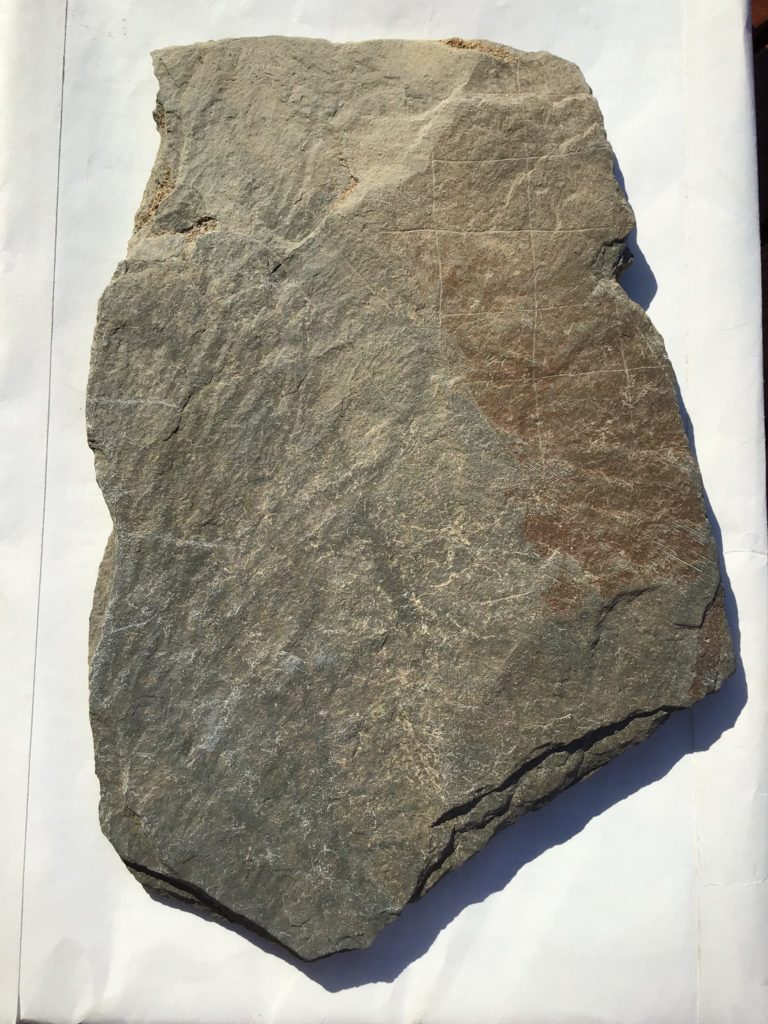
A layer of charcoal and associated finds suggest that the area around the enclosure was used extensively for craft-working; amber, bronze and bone.
Around 750 – 800 CE a larger wall was built around the entire structure, also with an entrance on the western side. Burial practices changed from almost exclusively infants to feature adults and sub-adults. From around 830 – 900 CE we see long-cist graves.
Around 1025 – 1150, the entire enclosure and shrine were overlaid with stone rubble. Adult burials ceased and the graveyard was again used for children. Finds include a Hiberno-scandinavian pin which would have been made in Ireland.
Finally, from around the 12th century onwards, burials ceased altogether. A small stone chapel was built of unmortared stones. Its entrance was again on the west side, though this was later closed up and a new entrance cut on the south side, perhaps because of the ever-encroaching sand.
Cyneswithe’s pilgrimage
Where does this leave Cyneswithe? In 922 AD, St David’s monastery is at the site of the present cathedral in the city we call St David’s. I assume that here it was firmly believed that David was born at St Non’s and educated at the now abandoned monastery on the site of Ty Gwyn.
Cyneswithe may have first visited St David’s as a young woman, guided by some older nun who knew the way, and on this visit in 922 she may have brought some of her sisters at Rumwoldstow to make the same journey. Perhaps the purpose of the trip was to accompany somebody travelling to Ireland and make sure she reached her departure point safely?
This trip would be no mean undertaking, a journey of several hundred miles from Rumwoldstow in Mercia. Cyneswithe perhaps went on foot as befits a pilgrim, or maybe by horse. It might have taken an entire season to make the journey and return, or perhaps Cyneswithe overwintered at the monastic community?
Either way, she will have had plenty of time during her visit to walk the few kilometres to St Non’s Bay to drink from the sacred spring at the site of David’s birthplace, a counterpart to her local sacred spring of St Rumwold’s birthplace in Sutton.23

On another day she walked to St Patrick’s shrine at Porth Mawr, which is a busy place when the tides are right for boats to pull up on the wide beach, goods are being carried inland and there is a bustle of travellers coming and going from Ireland. Despite all this activity, the shrine which is set a little way back from the sea is a place of contemplation and prayer.
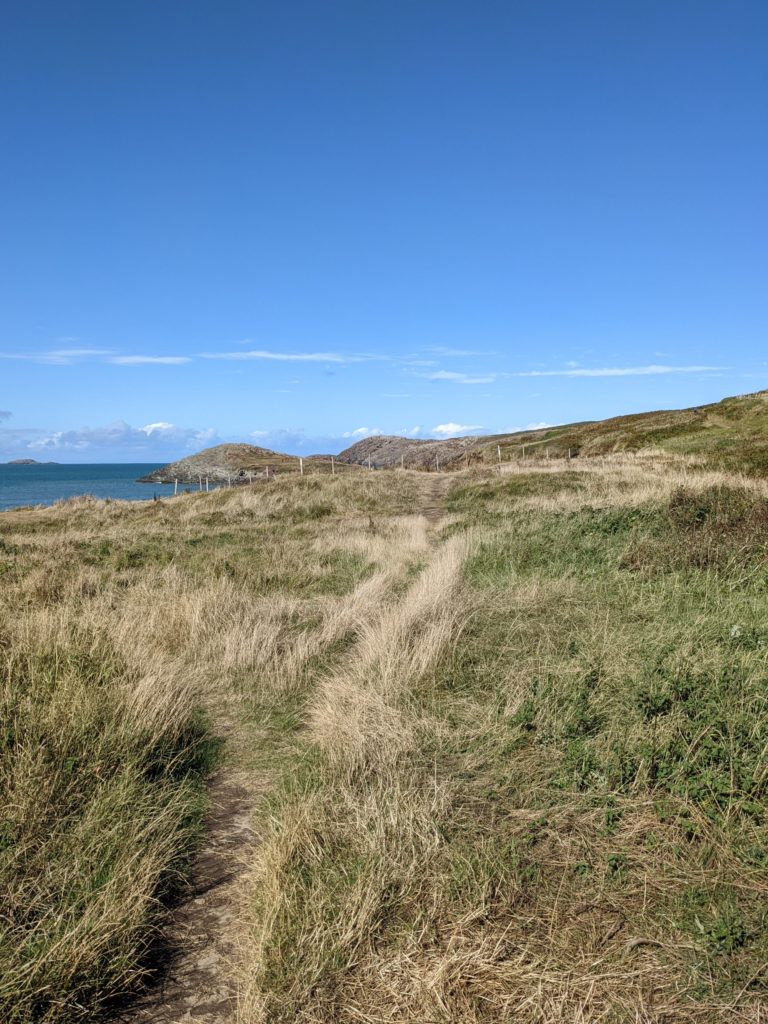
The shrine is marked by a vertical stone sticking out of the sand and is surrounded by stone markers of infant burials. The graveyard is enclosed by a low stone wall. It is well known that St Patrick’s shrine lies under the sands and that he will protect those infants who come into his care; indeed, Cyneswithe recalls that when she visited in her youth, the shrine was still visible, though surrounded by sand.
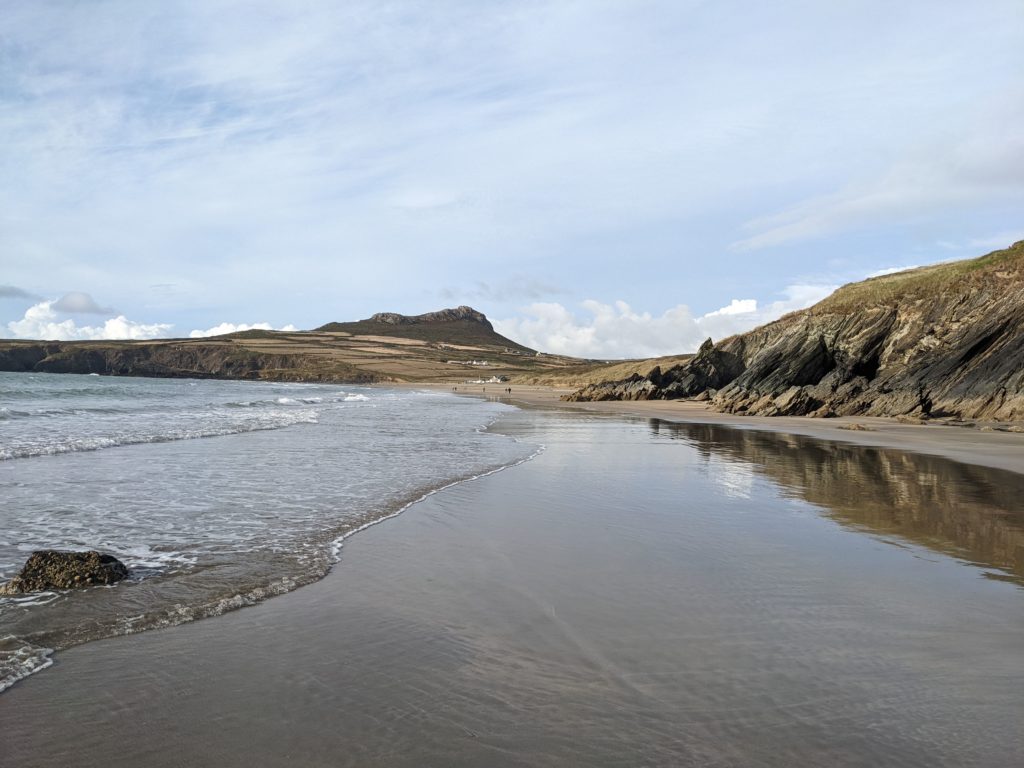
On that day Cyneswithe also climbed the stony lane to the abandoned monastic site at Ty Gwyn, now a small-holding. Here she reflected on the Christian tradition of learning, as espoused by King Alfred and assisted by the monastics of St David’s in her own lifetime. On her return to the glorious sandy beach, tempted by fine weather and the novelty of the ocean, she hitched up her skirts and waded in the sea, enjoying the feel of the fine sands beneath her toes. A seal swimming past reminded her of St Cuthbert and his friendship with wild creatures – and she felt blessed by this connection to the Northumbrian saint, across the miles and years.
It saddens me that St Patrick’s chapel and the underlying shrine are no longer resting at St David’s Head, as they have done for so many hundreds of years. However the excavation was absolutely necessary rescue archaeology, and it amazes me to have so much information about the site in Cyneswithe’s time which was not available just a year ago when I last visited here. I am deeply grateful to the team at Dyfed Archaeological Trust for making information available so quickly.
I began writing this post in the second Elizabethan Age; I am now writing in the reign of King Charles III, following the death of Queen Elizabeth II on 8th September 2022.24 Although unrelated to my historical researches, a sense of the flow of events has added intensity to my feelings about this journey. I signed the book of remembrance in the cathedral, and grieved for my own losses, in particular that of my father in 2019.
If you have reached the end of this rambling excursion, please consider yourself a fellow pilgrim and I wish you great joy of the beauties of St David’s Head!